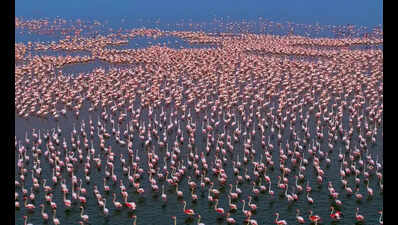Jaipur: Sambhar Lake, India’s largest inland saltwater lake and a designated Ramsar site, is witnessing an extraordinary influx of migratory birds this winter — a rise of nearly 40% compared to last year.Experts attribute this surge to the lake’s highest water levels in several years, creating near-perfect conditions for migratory species.Gaurav Dadhich, a wildlife expert, said: “This year the lake is full — water levels are higher than they have been in five decades. Such conditions are ideal for migration. During the recent waterbird census, the bird count was found to be 35% to 40% higher than last year.”According to census figures, lesser flamingos (Phoeniconaias minor) numbered nearly 32,000, while greater flamingos (Phoenicopterus roseus) were estimated at 35,000. Other notable species included northern shovelers (Spatula clypeata) numbering around 33,000, common teals (Anas crecca) at 21,000, and Kentish plovers (Charadrius alexandrinus), around 5,500, among several others.Spanning the districts of Jaipur, Nagaur, and Ajmer in Rajasthan, the lake’s area fluctuates between 190 and 230 sq km, depending on rainfall. This year, heavy monsoon rains have replenished the basin, drawing in flocks from across Central Asia and Europe.All is not idyllic though. A few migratory birds were found dead near Khakharki village in Nawa area on the Nagaur district side.Officers from forest and animal husbandry department launched rescue operations after reports of several birds appearing weak and unable to fly. Injured birds are being treated at rescue centres, while carcasses are being disposed of in accordance with safety protocols.A senior forest officer said: “The dead birds are being disposed of as per the SOP, and samples are being sent to the Central Avian Research Institute, Bareilly, to confirm whether avian botulism is the cause. All necessary precautions are being taken.”The last major outbreak of avian botulism occurred in 2019, when around 18,000 birds died.Dr Dau Lal, zoologist with a PhD in animal microbiology and wildlife, said: “Avian botulism is caused by toxins produced by Clostridium botulinum, an anaerobic bacterium that can survive in the soil for years. It multiplies in decaying carcasses and scavenging birds ingest the toxin when they feed on maggot-infested remains, leading to paralysis. Flamingos, which feed on algae rather than meat, are rarely affected.“Lal said the likelihood of botulism this year appears low due to abundant rainfall and the lake’s high water level. Industrial effluents and untreated wastewater entering the lake may still pose a threat.An animal husbandry department officer said minor casualties are expected in such large gatherings of birds: “With 2 to 3 lakh birds arriving, a few natural deaths are inevitable.”
Sambhar sees huge surge in migratory birds amid record water levels | Jaipur News





